
OK, you know the score by now. Power specialist IsoTek recently launched its V5 generation upgrades to improve on the EVO3 technology it replaces. The company is systematically upgrading each product from EVO3 to V5. V5 products look very different from EVO3, and the performance gets a big boost under the hood. And now it’s the turn of the IsoTek V5 Sigmas power conditioner.
Before we look at the V5 Sigmas, remember what it replaces. The squared-off EVO3 Sigmas remains an excellent six-way power conditioner. It has two 16A outlets for the transient demands of power amplifiers. Both are driven by a pared-down version of the EVO3 Titan’s Direct Coupled conditioning network. These are met by four Adaptive Gating 10A medium-power outlets for sources and preamps. This technology – brought up to V5 standard – is common to both Sigmas. However, if you listen to the two side-by-side, you might never guess that.
Trickle-down Titan
The Titan arrived in V5 guise last year; we tested it in Issue 209 and gave it a 2022 Award. The technology in that big hitter filters down to the V5 Sigmas. V5 Sigmas is also the bigger brother to the V5 Aquarius, which we tested in Issue 200. So, this isn’t our first V5 rodeo.
Although both share ‘trickle-down’ tech from their respective Titans, IsoTek’s V5 Sigmas distinctly differs from its EVO3 predecessor. Physically, it has a taller, more rounded cabinet with grooves cut into the top two-thirds of the front and side panels. This contrasts with the shorter, squarer 2009-era box of the EVO3 Sigmas.
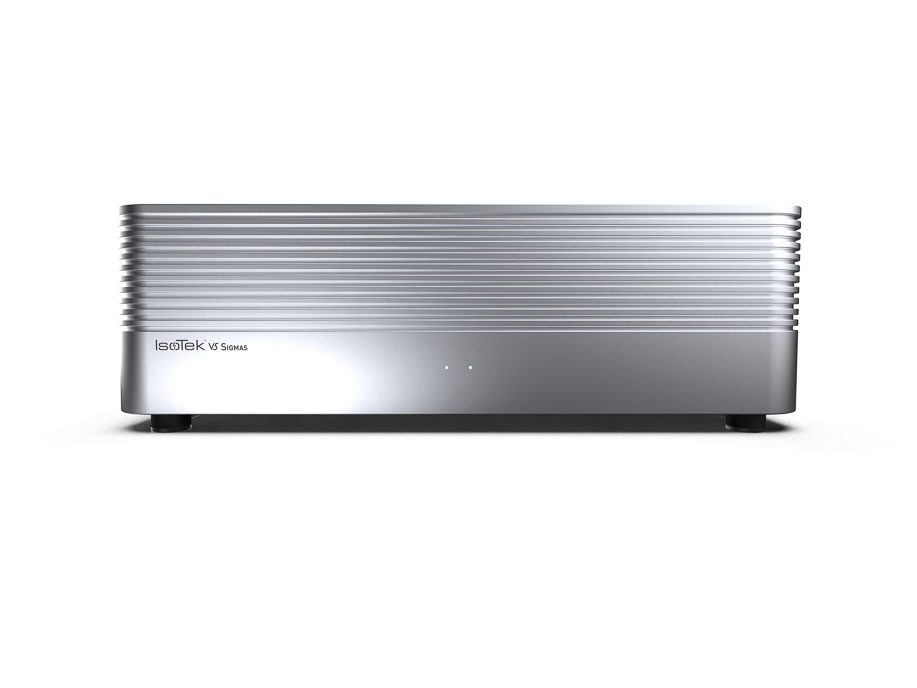
Extra input and fancy case aside, what’s changed in the V5 version? IsoTek has decreased the resistance in the overall circuit design, resulting in a claimed 35% increase in amperage. It has also boosted current handling capacity by a suggested 40%. In addition, the direct current resistance (DCR) has improved. This brings the design closer to the notional ideal of zero ohms.
Physical change
The most notable physical change is an extra 16A high-power outlet. The V5 Sigmas has three, and the EVO3 Sigmas has two. These high-current, low-impedance outlets can deliver 3,680W (or 1,840W for 115V regions). If used on a dedicated 20A spur with an associated wall outlet. However, for transients, it is possible to pull more than 13A through a standard wall socket, and the V5 Sigmas circuit can easily handle the amperage. They use a ‘lite’ V5 Titan’s Direct Coupled circuit version. Three might seem like a waste of an outlet to die-hard two-channel fans. However, adding a third ‘big juice’ outlet significantly benefits active systems, home cinema/theatre applications and custom installations.
Like the EVO3 Sigmas, the V5 has four 10A sockets optimised for source components. These also feature IsoTek’s auto-load sensing ‘Adaptive Gating’ system, giving the optimal clean power feed based on power draw. The power cleaning network is more sophisticated than that of Aquarius.
If four 16A and four 10A sockets are insufficient, V5 Sigmas also sports a System Link outlet. This Neutrik connector is designed to connect multiple units. It also preserves a starred-earth reference and removes the need for numerous wall outlet sockets. All seven power cleaning sockets of the IsoTek V5 Sigmas are independent, and the network is star-earthed.
Independence Day
The independence of those sockets should be considered. Even some otherwise excellent power conditioners and filters join output sockets, running each in series. This, suggests IsoTek, is an error as Differential Mode noise created by your connected electronics will cross-contaminate from one output socket to the next. The IsoTek Sigmas joins other IsoTek products in giving each socket ‘Boston Tea Party’ levels of independence. Cross-contamination of connected components is also kept to a minimum due to the multiple power cleaning stages for each output socket. This helps the IsoTek V5 Sigmas power conditioner put Differential Mode noise in its place.
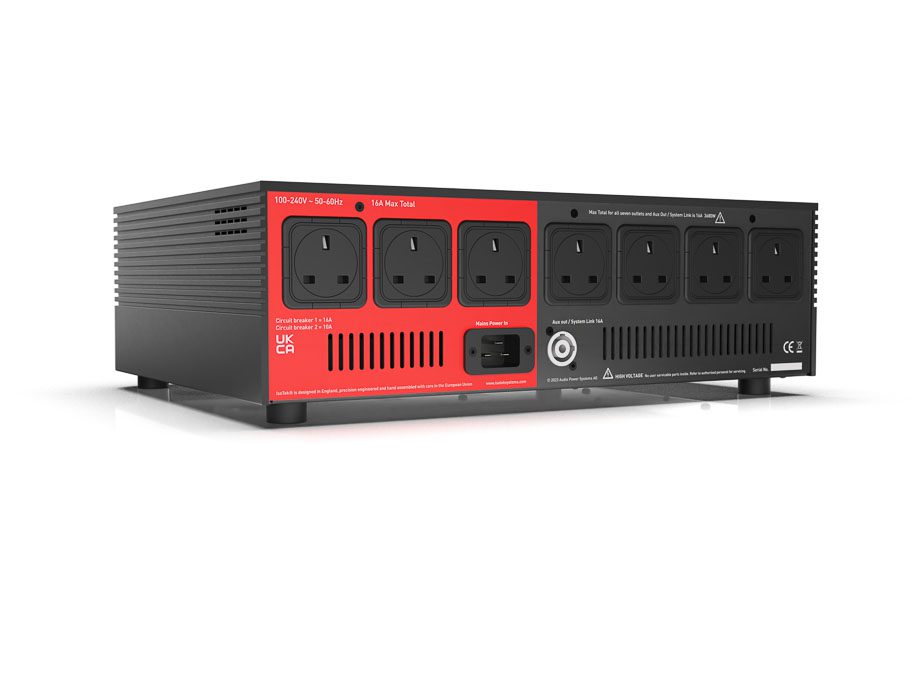
One of IsoTek’s flagship concepts from EVO3 Sigmas that still holds in V5 is KERP. Short for ‘Kirchhoff’s Equal Resistance Path’, KERP ensures equal resistance and power delivery to all outlets. The KERP concept demands close attention to internal cable composition and layout. It uses high-grade ultra-pure copper conductors – using the Ohno Continuous Casting process – throughout. These are wrapped in a helix of Fluorinated Ethylene Propylene (FEP). This is then housed in a FEP dielectric to create a virtual air dielectric. The result is an internal architecture of extremely low resistance.
The IsoTek V5 Sigmas power conditioner is recommended to use its range of power cords for greater KERP-related synergy. The V5 Sigmas comes supplied with an IEC C19 EVO3 Premier power cord. IsoTek says that “one critical but overlooked area is maintaining commonality of design and material properties through an audio wiring loom, be it signal-carrying cables or your power cable network.” While Mandy-Rice Davies’s cutting response –“Well, he would, wouldn’t he?” – applies, using IsoTek cords throughout does prove out in the listening.
Last line of defence
If this is your first IsoTek product, powering up the V5 Sigmas might seem unusual. There is no front or rear panel switch, and the two switches on the underside look ‘electrical’. That’s a deliberate feature because there is 121,500A of instantaneous protection behind the switch. It uses IsoTek’s sequential protection system. A power filter is also your system’s last line of defence against significant power surges. Rather than put that position of trust into a simple fuse, IsoTek uses a resettable circuit breaker. This doubles up as a power switch for the low and high-power sides of the V5 Sigmas.
The jump from EVO3 to V5 might be considered ‘evolution’ and not ‘revolution,’ but only on paper. In real-world performance terms, it’s a honking great step forward in sound. We had EVO3 and V5 Sigmas samples to compare, but it quickly proved academic. The difference was so marked that the EVO3 returned to its box fast.
In the first line of this review, I said, “You know the score by now.” That also applies to the V5 Sigmas’ performance. The usual IsoTek boons of a more dynamic sound rising out of a blacker, less ‘hashy’ or ‘electronicky’ background apply. The sound is more balanced, more neutral, and, like your audio electronics, less flustered. The direct result of this is greater articulation and definition in the bass and less congested-sounding higher frequencies.
More air
More high-frequency air and precision also give rise to a broader and deeper soundstage. These improvements helped make the EVO3 range – including the Sigmas – stand out. The upgrades to the latest models make the V5 Sigmas stand out from the EVO3. All of those usual IsoTek sonic benefits apply, just more so.
The comparison between EVO3 and V5 Sigmas might be fair, but it doesn’t sound fair. Unless it’s used with an amp beyond the Sigmas scope, I’d argue the V5 is closer in performance to the EVO3 Titan. That’s how much better the V5 Sigmas sounds. There’s more to this, though. The IsoTek V5 Sigmas power conditioner makes your system sound more cogent and coherent in a way the EVO3 models only hint at. When using ‘cold’ (in a system with no power filter in place), the level of improvement is little short of a wonder.
The amount of performance I can extract from the Primare I35 Prisma continues to surprise me. However, the difference between the I35 yoked to the wall and harnessing the V5 Sigmas is like changing amplifiers. The Primare’s already good bass takes on greater precision and authority. The midrange becomes more natural and open. The treble loses that hint of Class D glare, making the ‘au natural’ I35 sound disjointed.
Earth to Sigmas
With most power filters and conditioners, there’s a trade-off. The added staging refinement comes at the expense of the music’s rhythmic and dynamic properties. IsoTek’s V5 Sigmas is a rare exception. It doesn’t undermine the rhythmic integrity of music. However, the more ‘earthy’ sound of the EVO3 Sigmas is closer than V5 to the sound of no filter. Those who like that more ‘earthy’ and ‘gritty’ sound might find the V5 just slightly too refined. Most, however, will either never hear that nuance, like their sound less coarse, or even prefer the V5 anyway!
There’s a question always asked; is it worth upgrading? Often, the answer is ‘no’; the change is incremental, and you aren’t going to get a big performance boost. That’s not the case with the IsoTek V5 Sigmas. The change on paper is not as big as the real-world boost in performance. The EVO3 Sigmas made decent systems sound more realistic, and the V5 Sigmas improves upon that realism significantly. The IsoTek V5 Sigmas power conditioner will improve the performance of a good medium-sized or larger audio system. It could be your first IsoTek product. If it isn’t, and you have an EVO3 Sigmas, a V5 Sigmas is your next upgrade.
Technical specifications
- Type Power filter and conditioner
- Number of outlets Seven (4× medium current, 3× high current)
- Type of outlets UK, EU, US, AUS, CH
- Mains Inlet 16A IEC C20
Mains Voltage 100–240V/50–60Hz - Medium current outlets, 240V (10A 2.3kW total per outlet)
- Medium current outlets, 115V (10A 1.15kW total per outlet)
- High current outlets, 240V (16A 3.68kW total per outlet)
- High current outlets, 115V (16A 1.84kW total per outlet)
- System Link 1× Neutrik connector
- Surge protection 121,500A
- Finishes Black, Silver
- Dimensions (W×H×D) 44.5 × 15 × 35cm
- Weight 15kg
- Price £4,795, $4,995
Manufacturer
IsoTek Systems
UK distributor
SCV Distribution
+44 (0)330 122 2500
By Alan Sircom
More articles from this authorRead Next From Review
See all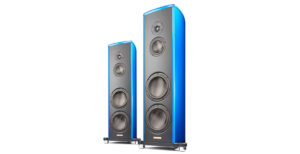
Magico S3 floorstanding loudspeaker
- Jun 27, 2024

Lowther Hegeman Sound Reproducer
- Jun 27, 2024
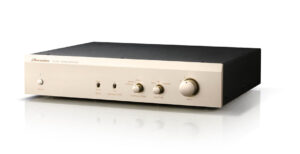
Phasemation EA-350
- Jun 19, 2024
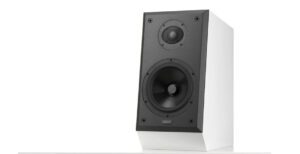
Epos ES14N
- Jun 19, 2024










